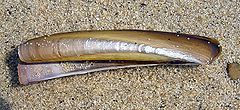Razor shell
| Razor shell | |
|---|---|
 |
|
| Scientific classification | |
| Kingdom: | Animalia |
| Phylum: | Mollusca |
| Class: | Bivalvia |
| Order: | Veneroida |
| Family: | Pharidae |
| Genus: | Ensis |
| Species: | E. arcuatus |
| Binomial name | |
|
Ensis arcuatus (Jeffreys, 1865) |
|
The razor shell, Ensis arcuatus, also called razor clam, razor fish, or spoot (colloquially), is a bivalve of the family Pharidae. It is found on sandy beaches in Northern Europe (south to Bay of Biscay) and Eastern Canada, such as Prince Edward Island, and in Kuwait's sandy beaches where it is very common.
In some locations, the common name "razor shell" is also used to refer to members of the family Solenidae, including species of the genera Ensis and Solen, by some taxonomic classifications which include the family Pharidae within the family Solenidae. It prefers coarser sand than its relatives E. ensis and E. siliqua.
It is known for its elongated, rectangular shape, whose similarity to the straight razor gives it its name. The razor shell has been known to reach 23 centimetres (9.1 in) in length. The dorsal margin is straight while the ventral margin is curved. It can easily be confused with the slightly shorter 15 centimetres (5.9 in) and more curved E. ensis (in which both front and back are curved in parallel).
Razor shells have a fragile shell, with open ends. The shell is smooth on the outside and whitish in color, with vertical and horizontal reddish-brown or purplish-brown markings separated by a diagonal line. The periostracum is olive-green. The inner surface is white with a purple tinge and the foot is creamy white with brown lines.
The razor shell lives under the sand, using its powerful foot to dig to a safe depth. Its digging activity comprises six stages, repeated cyclically. A digging cycle involves integration of the muscular foot (which takes up a large part of the body) with the opening and closing of the valve and one end. The foot is inflated hydraulically, extending down into the sand and anchoring the animal. Deflation of the foot then draws the shell down. The razor shell also squirts water down into the sand, removing loose sand from its path. The foot is thought to exert a pressure of about 196kPa (2 kgf/cm2).
...
Wikipedia
